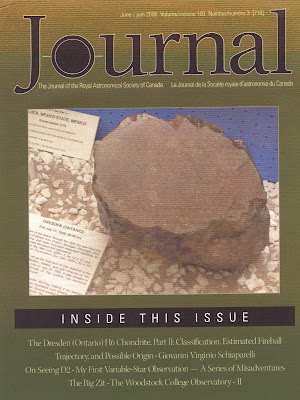Tonight, there is the possibility of a spectacular meteor show in the east south east sky just before midnight. Likely though, it will be overcast in our area!
It is near the constellation Monoceros, the unicorn. It will only last a short period of time, peaking around 11:50 p.m. from what I have read. Up to 400 meteors per hour can be expected. It depends where you are in North America though. Our area is fair to good.
Here is an article on the subject:
www.skyandtelescope.com/astronomy-news/observing-news/intense-meteor-outburst-expected-alpha-monocerotids/
Meteors are usually from the dust of comets when the earth passes through their trails. They can be annual events such as the Perseids in August.
I have always had an interest in the sky. It reminded me of an interesting event that occured near Dresden some time ago. I wrote about it in a blog post back in 2012.....
A while back, I read about a meteorite that came to earth southwest of Dresden Prince Albert Road
Meteorites come to earth all the time, but most are quite minute and disintegrate by the time they reach the lower reaches of the earth’s atmosphere. On rare occasions, sizable chunks will hit the earth, and these are highly sought after by collectors and scientists.
The rock that came down in 1939 in Chatham-Kent was in fact quite large. Several pieces were found scattered over nearby farms, but the largest piece, weighing about 40 kg dug itself about two metres into the sugar beet field of Dan Solomon. It became officially known as the Dresden Meteorite.
The next morning, Mr. Solomon attempted to dig up the meteorite. It had made a hole about 30 cm by 45 cm, with chunks of earth thrown 13 m away.
It did not take long before collectors made offers to purchase the meteorites. Not knowing in the beginning of the value of such a find, Solomon sold his rock for a mere $4.00. A meteorite like that was worth several hundred dollars at the time, and Solomon quickly realized he had been taken advantage of. It remained a family sore spot for a long time.
The purchase was made by Luke Smith a former Chatham
Several other fragments were recovered, totaling at least twelve. These were strewn along the Prince Albert Road north
Howard Plotkin, Department of Philosophy at UWO, has done extensive research on this meteorite. He published an article in April 2006 in the Royal Astronomical Society of Canada’s journal, from which some of the information for this writing was obtained.
Howard Plotkin knew the injustice that Dan Solomon had experienced, and decided to hold a special dinner at UWO to pay tribute to the Solomon family and the Dresden
The Dresden
Meteor showers, different than a single fireball, are fun to watch. There are the well-known ones such as the Perseids in August, and the Leonids in November. These and many others are caused by the earth passing through the dust of comets. Other meteorites are of space debris from bodies such as asteroids or planets.
Once in a while, you may get lucky and see a fireball. I did during the fall of 1982 when I was at the University of Guelph Ohio

No comments:
Post a Comment